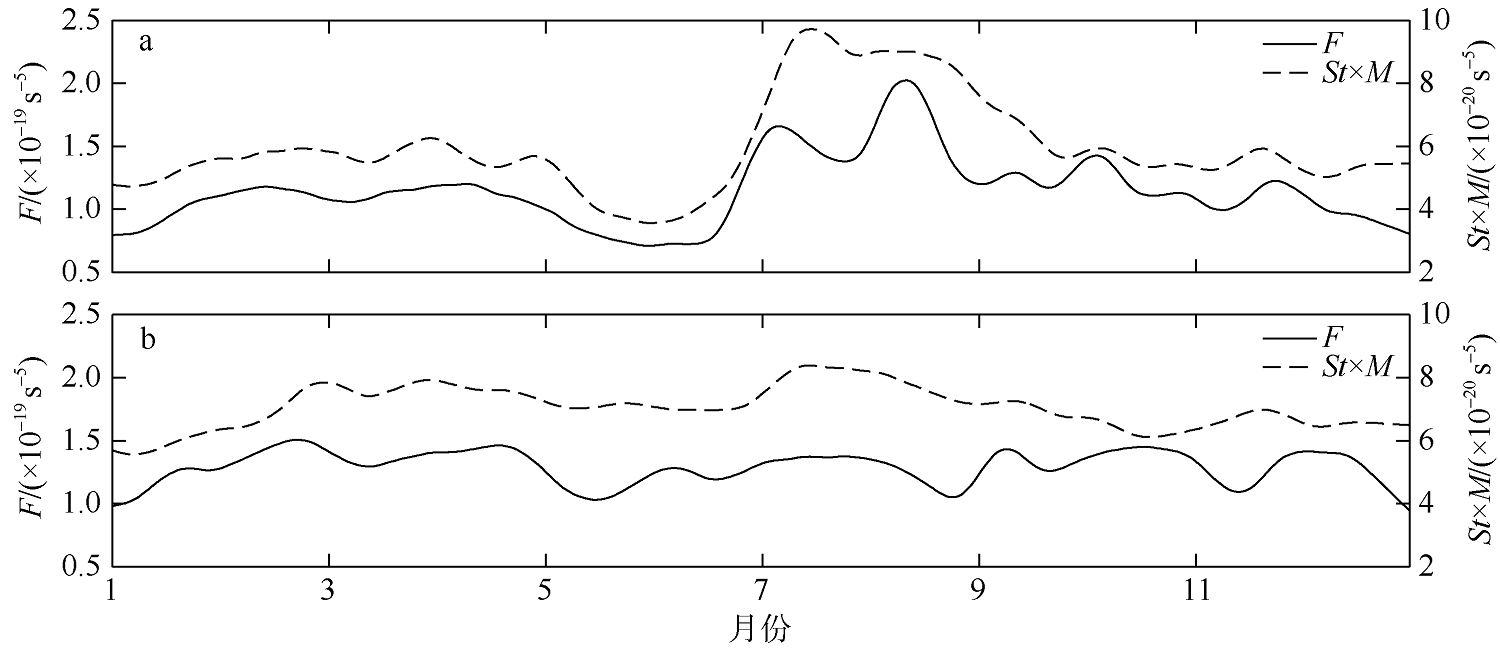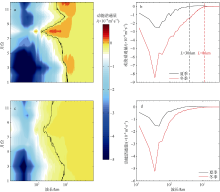Journal of Tropical Oceanography ›› 2021, Vol. 40 ›› Issue (1): 1-11.doi: 10.11978/2019140CSTR: 32234.14.2019140
• Marine hydrology • Next Articles
Seasonal variability of submesoscale flows in the Kuroshio Extension
LUO Shihao1,2( ), JING Zhiyou1, YAN Tong1, ZHENG Ruixi1,2, CAO Haijin3, QI Yiquan3
), JING Zhiyou1, YAN Tong1, ZHENG Ruixi1,2, CAO Haijin3, QI Yiquan3
- 1. State Key Laboratory of Tropical Oceanography (South China Sea Institute of Oceanology, Chinese Academy of Sciences), Guangzhou 510301, China
2. University of Chinese Academy of Sciences, Beijing 100049, China
3. College of Oceanography, Hohai University, Nanjing, 210098, China
-
Received:2019-12-13Revised:2020-04-04Online:2021-01-10Published:2020-04-09 -
Supported by:Original Innovation Project of Basic Frontier Scientific Research Program of Chinese Academy of Sciences(ZDBS-LY-DQC011);National Natural Science Foundation of China(92058201);National Natural Science Foundation of China(41776040);Innovation Academy of South China Sea Ecology and Environmental Engineering, CAS(ISEE2018PY05);Laboratory for Ocean Dynamics and Climate, Pilot Qingdao National Laboratory for Marine Science and Technology(OCFL-201804);Guangzhou Science and Technology Project(201904010420)
CLC Number:
- P731.27
Cite this article
LUO Shihao, JING Zhiyou, YAN Tong, ZHENG Ruixi, CAO Haijin, QI Yiquan. Seasonal variability of submesoscale flows in the Kuroshio Extension[J].Journal of Tropical Oceanography, 2021, 40(1): 1-11.
share this article
Add to citation manager EndNote|Reference Manager|ProCite|BibTeX|RefWorks
| [1] | 胡冬, 陈希, 赵艳玲, 等, 2018. 两个西边界流延伸体区域中尺度涡统计特征分析[J]. 海洋学报, 40(6):15-28. |
| HU DONG, CHEN XI, ZHAO YANLING, et al, 2018. Statistical characteristics of mesoscale eddies in the two western boundary current extension regions[J]. Acta Oceanologica Sinica, 40(6):15-28 (in Chinese with English abstract). | |
| [2] | 李宏杰, 徐永生, 2017. 北太平洋副热带逆流区涡旋动能谱的季节性变化及其机制[J]. 海洋与湖沼, 48(5):932-943. |
| LI HONGJIE, XU YONGSHENG, 2017. Seasonal variation in eddy kinetic energy spectrum and its mechanism in the north Pacific subtropical countercurrent[J]. Oceanologia et Limnologia Sinica, 48(5):932-943 (in Chinese with English abstract). | |
| [3] | 罗士浩, 经志友, 齐义泉, 等, 2016. 南海北部次中尺度过程数值研究[J]. 热带海洋学报, 35(5):10-19. |
| LUO SHIHAO, JING ZHIYOU, QI YIQUAN, et al, 2016. Numerical study on sub-mesoscale processes in the northern South China Sea[J]. Journal of Tropical Oceanography, 35(5):10-19 (in Chinese with English abstract). | |
| [4] | 张菀伦, 刘志亮, 王世红, 2017. 南黄海涡动能及其谱特征的季节性变化[J]. 海洋科学, 41(3):130-137. |
| ZHANG WANLUN, LIU ZHILIANG, WANG SHIHONG, 2017. Seasonal variations of eddy kinetic energy and its spectral characteristics in the southern Yellow Sea[J]. Marine Sciences, 41(3):130-137 (in Chinese with English abstract). | |
| [5] | 郑瑞玺, 经志友, 罗士浩, 2018. 南海北部反气旋涡旋边缘的次中尺度动力过程分析[J]. 热带海洋学报, 37(3):19-25. |
| ZHENG RUIXI, JING ZHIYOU, LUO SHIHAO, 2018. Analysis of sub-mesoscale dynamic processes in the periphery of anticyclonic eddy in the northern South China Sea[J]. Journal of Tropical Oceanography, 37(3):19-25 (in Chinese with English abstract). | |
| [6] | BOCCALETTI G, FERRARI R, FOX-KEMPER B, 2007. Mixed layer instabilities and restratification[J]. Journal of Physical Oceanography, 37(9):2228-2250. |
| [7] | BRACCO A, LIU GUANGPENG, SUN DAOXUN, 2019. Mesoscale-submesoscale interactions in the Gulf of Mexico: From oil dispersion to climate[J]. Chaos, Solitons & Fractals, 119:63-72. |
| [8] | CALLIES J, FERRARI R, KLYMAK J M, et al, 2015. Seasonality in submesoscale turbulence[J]. Nature Communications, 6(1):6862. |
| [9] | CAPET X, MCWILLIAMS J C, MOLEMAKER M J, et al, 2008a. Mesoscale to submesoscale transition in the California Current System. Part II: frontal processes[J]. Journal of Physical Oceanography, 38(1):44-64. |
| [10] | CAPET X, MCWILLIAMS J C, MOLEMAKER M J, et al, 2008b. Mesoscale to submesoscale transition in the California Current System. Part III: energy balance and flux[J]. Journal of Physical Oceanography, 38(10):2256-2269. |
| [11] | CHELTON D B, DESZOEKE R A, SCHLAX M G, et al, 1998. Geographical variability of the first baroclinic Rossby radius of deformation[J]. Journal of Physical Oceanography, 28(3):433-460. |
| [12] |
D’ASARO E, LEE C, RAINVILLE L, et al, 2011. Enhanced turbulence and energy dissipation at ocean fronts[J]. Science, 332(6027):318-322.
doi: 10.1126/science.1201515 pmid: 21393512 |
| [13] | DUCET N, LE TRAON P Y, REVERDIN G, 2000. Global high - resolution mapping of ocean circulation from TOPEX/ Poseidon and ERS-1 and-2[J]. Journal of Geophysical Research: Oceans, 105(C8):19477-19498. |
| [14] | FERRARI R, WUNSCH C, 2009. Ocean circulation kinetic energy: reservoirs, sources, and sinks[J]. Annual Review of Fluid Mechanics, 41:253-282. |
| [15] | GULA J, MOLEMAKER M J, MCWILLIAMS J C, 2016. Submesoscale dynamics of a Gulf Stream frontal eddy in the South Atlantic Bight[J]. Journal of Physical Oceanography, 46(1):305-325. |
| [16] | GULA J, BLACIC T M, TODD R E, 2019. Submesoscale coherent vortices in the Gulf Stream[J]. Geophysical Research Letters, 46(5):2704-2714. |
| [17] | LARGE W G, MCWILLIAMS J C, DONEY S C, 1994. Oceanic vertical mixing: a review and a model with a nonlocal boundary layer parameterization[J]. Reviews of Geophysics, 32(4):363-403. |
| [18] | LEMARIÉ F, KURIAN J, SHCHEPETKIN A F, et al, 2012. Are there inescapable issues prohibiting the use of terrain-following coordinates in climate models?[J]. Ocean Modelling, 42:57-79. |
| [19] |
MAHADEVAN A, 2016. The impact of submesoscale physics on primary productivity of plankton[J]. Annual Review of Marine Science, 8:161-184.
doi: 10.1146/annurev-marine-010814-015912 pmid: 26394203 |
| [20] | MCWILLIAMS J C, 2016. Submesoscale currents in the ocean[J]. Proceedings of the Royal Society A: Mathematical, Physical and Engineering Sciences, 472(2189):20160117. |
| [21] |
MENSA J A, GARRAFFO Z, GRIFFA A, et al, 2013. Seasonality of the submesoscale dynamics in the Gulf Stream region[J]. Ocean Dynamics, 63(8):923-941.
doi: 10.1007/s10236-013-0633-1 |
| [22] | MOLEMAKER M J, MCWILLIAMS J C, DEWAR W K, 2015. Submesoscale instability and generation of mesoscale anticyclones near a separation of the California Undercurrent[J]. Journal of Physical Oceanography, 45(3):613-629. |
| [23] | QIU BO, SCOTT R B, CHEN SHUIMING, 2008. Length scales of eddy generation and nonlinear evolution of the seasonally modulated South Pacific Subtropical Countercurrent[J]. Journal of Physical Oceanography, 38(7):1515-1528. |
| [24] | QIU BO, CHEN SHUIMING, KLEIN P, et al, 2016. Reconstructability of three-dimensional upper-ocean circulation from SWOT sea surface height measurements[J]. Journal of Physical Oceanography, 46(3):947-963. |
| [25] | RENAULT L, MCWILLIAMS J C, PENVEN P, 2017. Modulation of the Agulhas Current retroflection and leakage by oceanic current interaction with the atmosphere in coupled simulations[J]. Journal of Physical Oceanography, 47(8):2077-2100. |
| [26] |
RENAULT L, MCWILLIAMS J C, GULA J, 2018. Dampening of submesoscale currents by air-sea stress coupling in the Californian Upwelling System[J]. Scientific Reports, 8(1):13388.
pmid: 30190530 |
| [27] | ROCHA C B, GILLE S T, CHERESKIN T K, et al, 2016. Seasonality of submesoscale dynamics in the Kuroshio Extension[J]. Geophysical Research Letters, 43(21):11304-11311. |
| [28] |
SASAKI H, KLEIN P, QIU BO, et al, 2014. Impact of oceanic- scale interactions on the seasonal modulation of ocean dynamics by the atmosphere[J]. Nature Communications, 5(1):5636.
doi: 10.1038/ncomms6636 |
| [29] |
SASAKI H, KLEIN P, SASAI Y, et al, 2017. Regionality and seasonality of submesoscale and mesoscale turbulence in the North Pacific Ocean[J]. Ocean Dynamics, 67(9):1195-1216.
doi: 10.1007/s10236-017-1083-y |
| [30] |
SCOTT R B, WANG FAMING, 2005. Direct evidence of an oceanic inverse kinetic energy cascade from satellite altimetry[J]. Journal of Physical Oceanography, 35(9):1650-1666.
doi: 10.1175/JPO2771.1 |
| [31] |
SHCHERBINA A Y, D’ASARO E, LEE C M, et al, 2013. Statistics of vertical vorticity, divergence, and strain in a developed submesoscale turbulence field[J]. Geophysical Research Letters, 40(17):4706-4711.
doi: 10.1002/grl.50919 |
| [32] | THOMAS L N, TANDON A, MAHADEVAN A, 2008. Submesoscale processes and dynamics[M]// HECHT M W, HASUMI H. Ocean modeling in an eddying regime. American: American Geophysical Union: 17-38. |
| [33] |
THOMAS L N, TAYLOR J R, FERRARI R, et al, 2013. Symmetric instability in the Gulf Stream[J]. Deep Sea Research Part II: Topical Studies in Oceanography, 91:96-110.
doi: 10.1016/j.dsr2.2013.02.025 |
| [34] |
THOMPSON A F, LAZAR A, BUCKINGHAM C, et al, 2016. Open-ocean submesoscale motions: a full seasonal cycle of mixed layer instabilities from gliders[J]. Journal of Physical Oceanography, 46(4):1285-1307.
doi: 10.1175/JPO-D-15-0170.1 |
| [35] |
ZHANG ZHENGGUANG, QIU BO, 2018. Evolution of Submesoscale Ageostrophic motions through the life cycle of oceanic Mesoscale Eddies[J]. Geophysical Research Letters, 45(21):11847-11855.
doi: 10.1029/2018GL080399 |
| [36] |
ZHANG ZHENGGUANG, QIU BO, KLEIN P, et al, 2019. The influence of geostrophic strain on oceanic ageostrophic motion and surface chlorophyll[J]. Nature Communications, 10(1):2838.
pmid: 31253812 |
| [37] | ZHANG ZHIWEI, TIAN JIWEI, QIU BO, et al, 2016. Observed 3D structure, generation, and dissipation of oceanic mesoscale eddies in the South China Sea[J]. Scientific Reports, 6(1):24349. |
| [38] | ZHANG ZHIWEI, ZHANG YUCHEN, QIU BO, et al, 2020. Spatiotemporal characteristics and generation mechanisms of submesoscale currents in the northeastern South China Sea revealed by numerical simulations[J]. Journal of Geophysical Research: Oceans, 152(2). |
| [39] | ZHONG YISEN, BRACCO A, TIAN JIWEI, et al, 2017. Observed and simulated submesoscale vertical pump of an anticyclonic eddy in the South China Sea[J]. Scientific Reports, 7(1):44011. |
| [1] | ZHANG Zhisheng, XIE Lingling, LI Junyi, LI Qiang. Comparative analysis of mesoscale eddy evolution during life cycle in marginal sea and open ocean: South China Sea and Kuroshio Extension [J]. Journal of Tropical Oceanography, 2023, 42(4): 63-76. |
| [2] | CHU Xiaoqing, PENG Qihua. The role of alongshore wind and ocean wave in generating the northward Somali Current [J]. Journal of Tropical Oceanography, 2023, 42(2): 1-8. |
| [3] | CHENG Xiawen, ZHANG Lanlan, QIU Zhuoya, XIANG Rong, CHANG Hu. Biodiversity, biogeography and seasonal variation of zooplankton Collodarians (Radiolaria) in surface waters from the northern Indian Ocean to the South China Sea* [J]. Journal of Tropical Oceanography, 2023, 42(2): 97-112. |
| [4] | ZHANG Xu, JING Zhiyou, ZHENG Ruixi, HUANG Xiaolong, CAO Haijin. Submesoscale characteristics of a typical anticyclonic mesoscale eddy in Kuroshio Extension* [J]. Journal of Tropical Oceanography, 2021, 40(6): 31-40. |
| [5] | YANG Xiaoxiao, CAO Haijin, JING Zhiyou. Spatial and seasonal differences of the upper-ocean submesoscale processes in the South China Sea [J]. Journal of Tropical Oceanography, 2021, 40(5): 10-24. |
| [6] | Xiaowen ZHOU, Haijin CAO, Zhiyou JING, Guanghong LIAO. Anisotropy of submesoscale eddy in Kuroshio Extension based on high resolution ROMS output analysis [J]. Journal of Tropical Oceanography, 2020, 39(3): 10-18. |
| [7] | Yuzheng REN, Zhixin KE, Yehui TAN, Kaizhi LI. Community structure of zooplankton and its influencing factors in the eastern waters of Nan’ao Island, Guangdong [J]. Journal of Tropical Oceanography, 2020, 39(2): 65-76. |
| [8] | Junpeng ZHAO, Yihan LI, Wenping GONG. The seasonal and sporadic variation of the spreading of a small tropical river plume and its associated dynamics [J]. Journal of Tropical Oceanography, 2017, 36(4): 67-76. |
| [9] | Qiwei SUN, Yan DU, Yuhong ZHANG. Seasonal variability of sea surface salinity in tropical Southern Indian Ocean based on Argo and Aquarius observations [J]. Journal of Tropical Oceanography, 2017, 36(4): 25-34. |
| [10] | LUO Shihao, JING Zhiyou, QI Yiquan, XIE Qiang. Numerical study on sub-mesoscale processes in the northern South China Sea [J]. Journal of Tropical Oceanography, 2016, 35(5): 10-19. |
| [11] | CHEN Biao, WANG Jing, JING Zhiyou, LI Min. Seasonal and interannual variation of thermal fronts off the east coast of Hainan Island and the west coast of Guangdong [J]. Journal of Tropical Oceanography, 2016, 35(5): 1-9. |
| [12] | XUAN Li-li, QIU Yun, XU Jin-dian, ZENG Ming-zhang. Seasonal variation of surface-layer circulation in the eastern tropical Indian Ocean [J]. Journal of Tropical Oceanography, 2014, 33(1): 26-35. |
| [13] | LI Zi-mu, CAI Shu-qun, CHEN Ju, CHEN Rong-yu, WANG Dong-xiao, DU Yan. Preliminary analysis of observations by deep submersible mooring in west Luzon Strait during 2010 to 2011 [J]. Journal of Tropical Oceanography, 2014, 33(1): 10-16. |
| [14] | LI Ping, ZHANG Qi-long, LIU Hong-wei, XU Jian-ping. Seasonal variation of meridional salt transport in the North Pacific Ocean [J]. Journal of Tropical Oceanography, 2012, 31(4): 28-34. |
| [15] | ZHANG Yu-hong,XU Hai-ming,DU Yan,WANG Dong-xiao. Seasonal variability of salinity budget in the southeastern Arabian Sea [J]. Journal of Tropical Oceanography, 2009, 28(5): 66-74. |
|
||





















